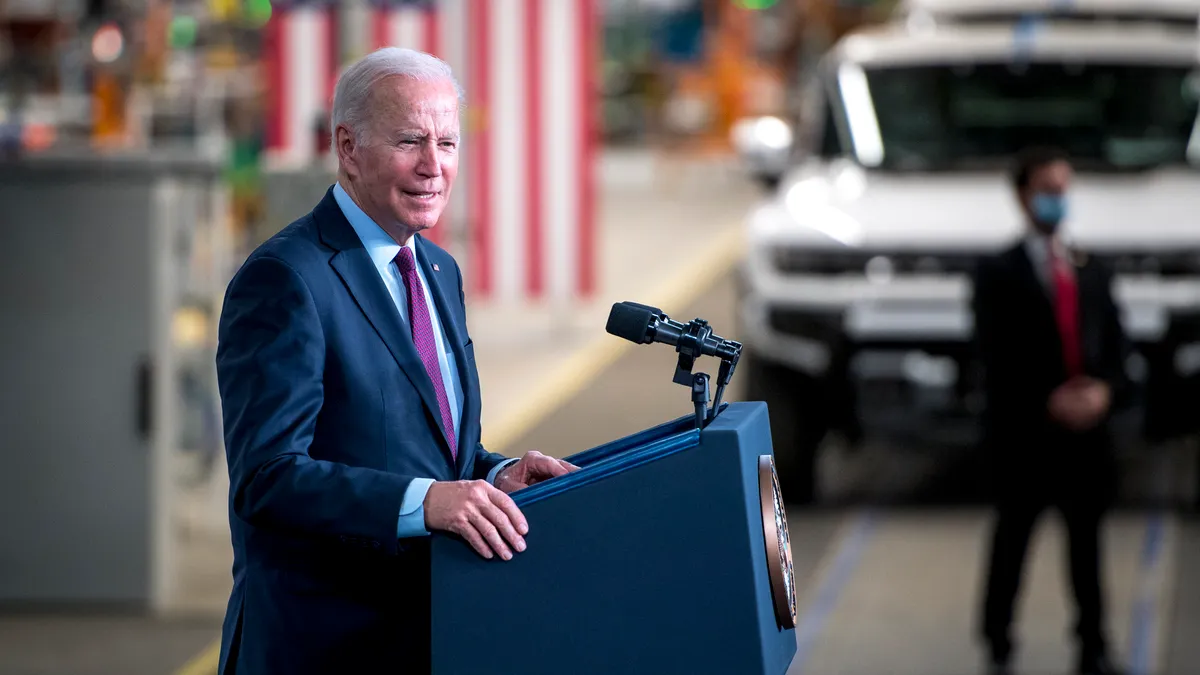UPDATE: Feb. 4, 2022: The Department of Defense and the General Services Administration issued a request for information Thursday looking for potential purchases of carbon-free electricity in areas with competitive wholesale markets starting in 2023.
"It's not just critical to addressing the threat of climate change, but also to our national security as we work to secure U.S. competitiveness in rapidly-shifting global energy markets," Deputy Secretary of Defense Kathleen Hicks said in a statement.
DOD and the GSA, which buy more than 9,000 GWh a year in competitive markets, said they plan to take a phased approach to the carbon-free electricity purchases by transiting existing retail supply contracts and making new power procurements.
Dive Brief:
-
The federal government — the largest U.S. energy consumer — will aim to get carbon-free electricity on a net annual basis by 2030, with half of it being emissions-free around the clock, under an executive order signed Wednesday by President Joe Biden.
-
In a boost for the electric vehicle (EV) sector, Biden barred the federal government from buying fossil-fueled light-duty vehicles by 2027, and any gas or diesel vehicles by 2035.
-
"The executive order is an attempt to use federal procurement power to send market signals," Margaret Peloso, a partner with Vinson & Elkins, said. "The government wants to buy more renewables. The government wants to buy more electric vehicles."
Dive Insight:
The federal government owns about 350,000 buildings, 650,000 cars and trucks, and spends $500 billion a year on goods and services, including about 53.8 million MWh of electricity, according to the Center for Biological Diversity, which last week petitioned the General Services Administration (GSA) to adopt climate-related procurement policies.
"Turning that part of the economy into a green force doesn't automatically mean everyone else follows, but it surely sends very serious market signals," Bill Snape, a senior counsel at the Center for Biological Diversity, said. "The United States government has a tremendous amount of ability to sway and influence clean, renewable power through its purchasing power."
The White House expects the federal government's planned clean energy purchases to spur the development of at least 10,000 MW of clean energy by the end of the decade.
In a move that matches corporate efforts, the federal government will seek to directly match its energy use with 24/7 emissions-free electricity from nearby power sources.
Generally, corporations have been ahead of the government in adopting climate-related goals, driven by investor and consumer demands, according to Peloso.
However, with the executive order and an early-stage rulemaking by the Federal Acquisition Regulatory Council, the government may become a leader on using procurement practices to reduce greenhouse gas emissions, Peloso said.
"It's an area where you could see the government jump back out ahead, especially if they start to do things like really look at sustainability throughout supply chains," Peloso said.
The 24/7 clean electricity procurement goal is "monumental," Michael Terrell, Google global head of energy, said on Twitter, noting Google and the federal government previously helped spur renewable energy markets.
"The federal government has the same opportunity to move the market toward round the clock clean energy, which in turn will drive electricity grids to 100% carbon-free energy, faster," Terrell said.
Buying emissions-free energy to match electricity use is critical to cutting carbon emissions because it supports the market for "firm" power sources like zero-carbon fuels, carbon capture and storage and nuclear energy, the Clean Air Task Force, an advocacy group, noted Wednesday. It also leads to higher carbon emissions reductions, the group said.
The executive order could also provide a boost to the EV sector.
The GSA, a federal procurement and real estate management agency, spends about $1.5 billion a year on vehicles. In the last fiscal year, federal agencies bought 47,350 vehicles through the GSA, according to the agency.
Biden ordered the Transportation Department and the GSA to coordinate with states, tribes and local governments to facilitate wider adoption of zero-emission vehicles and to use federal acquisition programs for non-federal purchasers.
The executive order requires agencies to let their properties, such as rooftops, parking structures and land, be used for emission-free electricity and energy storage.
Agencies must also consider how their climate spending can help meet a goal that 40% of the overall benefits from the investments go to disadvantaged communities. According to Biden's proposed 2022 budget, agencies must also consider their climate spending in the frame of a social equity goal: 40% of the overall benefits from climate investments must go to disadvantaged communities.
Biden's order reestablished the Office of the Federal Chief Sustainability Officer within the White House Council on Environmental Quality. The office will oversee efforts to implement the executive order.
Other goals in the executive order include:
- Cutting emissions from federal buildings in half by 2032 and having net-zero emissions by 2045;
- Reducing direct and energy-related greenhouse gas emissions from federal operations 65% below 2008 levels by 2030; and,
- Reaching net-zero emissions by 2050 from federal procurement, including using construction materials with lower embodied emissions.
The administration's efforts will cut carbon emissions, but it appears to be backtracking on its schedule for meeting certain targets, according to Snape. In April, for example, former GSA Acting-Administrator Katy Kale said the agency would buy only renewable energy by 2025, he noted.
Also, being carbon neutral or net zero implies there will still be some fossil fuel-based generation in the government's power supply, Snape said.
The executive order isn't clear on how the government would meet its net-zero commitments, according to Vinson & Elkins' Peloso.
"Is this a signal that the United States might become an active participant in the offset markets?" Peloso asked. "Or is this really meant to signal we're going to use procurement to drive our emissions down as far as we can, without really addressing the zero part?"















